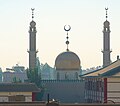An important feature in Chinese architecture is its emphasis on symmetry, which connotes a sense of grandeur; this applies to everything from palaces to mosques. One notable exception is in the design of gardens, which tends to be as asymmetrical as possible. Like Chinese scroll paintings, the principle underlying the garden's composition is to create enduring flow; to let the patron wander and enjoy the garden without prescription, as in nature herself.
On the foothills of Mount Lingshan are the tombs of two of the four companions that Muhammad sent eastwards to preach Islam. Known as the "Holy Tombs," they house the companions Sa-Ke-Zu and Wu-Ko-Shun—their Chinese names, of course. The other two companions went to Guangzhou and Yangzhou.
Chinese buildings may be built with bricks, but wooden structures are the most common; these are more capable of withstanding earthquakes, but are vulnerable to fire. The roof of a typical Chinese building is curved; there are strict classifications of gable types, comparable with the classical orders of European columns.
As in all regions the Chinese Islamic architecture reflects the local architecture in its style. China is renowned for its beautiful mosques, which resemble temples. However, in western China the mosques resemble those of the middle east, with tall, slender minarets, curvy arches and dome shaped roofs. In northwest China where the Chinese Hui have built their mosques, there is a combination of east and west. The mosques have flared Chinese-style roofs set in walled courtyards entered through archways with miniature domes and minarets. The first mosque was the Great Mosque of Xian, or the Xian Mosque, which was created in the Tang Dynasty in the 7th century.
Chinese mosques)
This is a list of notable mosques in China. A mosque is a place of worship for followers of the religion of Islam. The first mosque in China was the Great Mosque of Xi'an, built during the Tang Dynasty in the 8th century CE. Today there are over 39,000 mosques in China, 25,000 of these are in Xinjiang, a north-west autonomous region.
In China, mosques are called qīngzhēnsì (清真寺, "Pure truth temple"), a name which was also used by Chinese Jews for synagogues. Other names include huíhui táng (回回堂, "Hui people's hall"), huíhui sì (回回寺, "Hui people's temple"), lǐbàisì (礼拜寺, "Temple of worship"), zhēnjiào sì (真教寺, "True teaching temple"), or qīngjìng sì (清净寺, "Pure and clean temple").
During the Qing Dynasty, at the Mosque entrance of Hui Mosques, a tablet was placed upon which "Huángdì wànsuì, wànsuì, wànwànsuì" (皇帝萬歲,萬歲,萬萬歲) was enscribed, which means, "The Emperor, may he live forever". Wansui means Ten thousand years, which means forever in Chinese. Westerners traveling in China noted the presence of these tablets at mosques in Yunnan and Ningbo.
Most mosques have certain aspects in common with each other however as with other regions Chinese Islamic architecture reflects the local architecture in its style. China is renowned for its beautiful mosques, which resemble temples. However, in western China the mosques resemble those of Iran and Central Asia, with tall, slender minarets, curvy arches and dome shaped roofs, as well as the unique multi-layered portals. In northwest China where the Chinese Hui have built their mosques, there is a combination of eastern and western styles. The mosques have flared Buddhist style roofs set in walled courtyards entered through archways with miniature domes and minarets.
The style of architecture of Hui Mosques varies according to their sect. The traditionalist Gedimu Hanafi Sunnis, influenced by Chinese culture, build Mosques which look like Chinese temples. The reformist modernist (but originally Wahhabi inspired) Yihewani build their Mosques to look like Middle Eastern Arab style Mosques.
| Niujie Mosque |  | Xicheng | Beijing | 996 |
| Qingjing Mosque |  | Quanzhou | Fujian | |
| Dunhuang Mosque |  | Dunhuang | Gansu | |
| Huasi Mosque |  | Linxia | Gansu | |
| Huaisheng Mosque |  | Guangzhou | Guangdong | 627 |
| Nanning Mosque |  | Nanning | Guangxi | |
| Daowai Mosque |  | Harbin | ||
| List of mosques in Hong Kong | Hong Kong | |||
| Macau Mosque |  | Our Lady of Fatima Parish | Macau | |
| Tongxin Great Mosque |  | Tongxin | Ningxia | ca.1400 |
| Dongguan Mosque |  | Xining | Qinghai | 1380 |
| Jiezi mosque[12] | Xunhua Salar | Qinghai | ||
| Great Mosque of Xi'an |  | Xi'an | Shaanxi | 742 |
| Jinan Great Southern Mosque |  | Jinan | Shandong | |
| Fuyou Road Mosque |  | Huangpu | Shanghai | |
| Xiaotaoyuan Mosque |  | Huangpu | Shanghai | |
| Lhasa Great Mosque |  | Lhasa | Tibet | |
| Afaq Khoja Mausoleum |  | Haohan | Xinjiang | |
| Khotan Mosque |  | Hotan | Xinjiang | |
| Id Kah Mosque |  | Kashgar | Xinjiang | 1442 |
| Najiaying Mosque |  | Yuxi | Yunnan |
Source From Wikipedia
没有评论:
发表评论